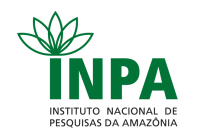Corpo Discente - Egressos
Raimundo Junior da Rocha Batista
| Título | CARACTERIZAÇÃO DO PERFIL QUÍMICO DE AROMA E EXTRATOS ORGÂNICOS DA FOLHA, PECÍOLO, CAULE, RIZOMA, RAIZ, BROTO E INFLORESCÊNCIA DE Montrichardia linifera (Arruda) Schott. | ||||||||||||||||||||||||
| Data da Defesa | 28/06/2019 | ||||||||||||||||||||||||
| Download | Em sigilo | ||||||||||||||||||||||||
Banca
| |||||||||||||||||||||||||
| Palavras-Chaves | Aninga;Prospecção fitoquímica;Constituintes voláteis;CCDAE | ||||||||||||||||||||||||
| Resumo | Montrichardia linifera (Arruda) Schott, família Araceae, é popularmente conhecida como aninga e amplamente disseminada nas várzeas amazônicas e encontrada em diversos ecossistemas inundáveis como igapós, margens de rios, furos e igarapés. São consideradas tóxicas, causando queimaduras de pele e em contato com os olhos pode causar cegueira. Apesar disso, são muito utilizadas na medicina tradicional por suas propriedades cicatrizantes, possível ação anti-inflamatória e antinociceptiva, tratamento de impingem e frieira, diurética e atividade antiplasmódica. Com base nestas informações, este projeto tem como objetivos: determinar a composição mineral (Ca, Mg, Cu, Fe, Zn e Mn) das folhas, pecíolo, caule, rizoma, raiz e broto de Montrichardia linifera e com esses dados, determinar o potencial de bioacumulação e fator de translocação; realizar a prospecção fitoquímica nos extratos oriundos das folhas, pecíolo, caule, rizoma, raiz e broto; realizar a caracterização química dos extratos brutos (hexano, acetato de etila, metanol e etanol) das folhas, pecíolo, caule, rizoma, raiz e broto de Montrichardia linifera e identificar os constituintes voláteis (aroma) das folhas, pecíolo, caule, rizoma, raiz, broto e inflorescência por cromatografia gasosa acoplada à espectrômetro de massas (CG-EM). Os resultados da composição mineral demostraram que os maiores teores de Ca, Mg e Mn foram observados nas partes aéreas da planta, folha, pecíolo, caule e broto e dentre os micronutrientes, concentrações elevadas de Mn, Fe e Cu nas raízes. Montrichardia linifera se mostrou eficaz em bioacumulação de metais em seus tecidos. Na prospecção fitoquímica do extrato etanólico foi detectada a presença de ácidos orgânicos e esteroides e triterpenos (folha, pecíolo, caule, raiz, rizoma e broto), açúcar redutor (pecíolo, caule, raiz e rizoma) e saponinas (pecíolo, raiz e rizoma). Na prospecção por CCDAE foi detectada a presença de terpenos nos extratos hexano, acetato de etila e etanol (folha, pecíolo, caule, raiz, rizoma e broto), flavonoides nos extratos metanol e etanol (folha), compostos fenólicos nos extratos metanol e etanol (folha) e acetato de etila (folha, pecíolo, caule, raiz, rizoma e broto) e atividade antioxidante no extrato hexano (folha e broto), acetato de etila e etanol (folha, caule, raiz e broto) e nos extrato metanólico (folha, pecíolo, caule, raiz, rizoma e broto). No perfil químico de Montrichardia linifera, foi possível a identificação total de 133 compostos. Nos extratos hexânico e acetato de etila foram identificados 45 compostos (31 no hexano e 25 no acetato de etila) e apresentaram como componentes majoritários, o ácido palmítico, octacosano e etil palmitato. Nos aromas foram identificados 114 constituintes químicos com o Ácido palmítico como principal constituinte majoritário (pecíolo, raiz e rizoma) hexanal (caule e broto) e (Z)jasmona e álcool veratril em todas as amostras da inflorescência (in natura e seca). | ||||||||||||||||||||||||
| Abstract | Montrichardia linifera (Arruda) Schott, family Araceae, is popularly known as aninga and widely disseminated in the Amazonian floodplains and found in several floodplain ecosystems such as igapós, riverbanks, holes and igarapés. They are considered toxic, causing skin burns and in contact with the eyes can cause blindness. Despite this, they are widely used in traditional medicine because of its cicatrizing properties, possible anti-inflammatory and antinociceptive action, treatment of impingee and chill, diuretic and antiplasmodic activity. Based on this information, the objective of this project is to determine the mineral composition (Ca, Mg, Cu, Fe, Zn and Mn) of the leaves, petiole, stem, rhizome, root and shoot of Montrichardia linifera. bioaccumulation potential and translocation factor; to carry out the phytochemical prospection in the extracts from the leaves, petiole, stem, rhizome, root and shoot; (hexane, ethyl acetate, methanol and ethanol) of the leaves, petiole, stem, rhizome, root and bud of Montrichardia linifera and and identifying the volatile constituents (aroma) of leaves, petiole, stem, rhizome, root, shoot and inflorescence by gas chromatography coupled to the mass spectrometer (GCMS). The results of the mineral composition showed that the highest concentrations of Ca, Mg and Mn were observed in the aerial parts of the plant, leaf, petiole, stem and bud and among the micronutrients, high concentrations of Mn, Fe and Cu in the roots. Montrichardia linifera has been shown to be effective in the bioaccumulation of metals in their tissues. The phytochemical screening of the ethanol extract was detected the presence of organic acids and steroids and triterpenoids (leaf, petiole, stem, root, rhizome and bud), reducing sugar (petiole, stem, root and rhizome) and saponins (petiole, root and rhizome). In prospecting by HPTLC was detected the presence of terpenes in hexane extracts, ethyl acetate and ethanol (leaf, petiole, stem, root, rhizome and bud), flavonoids in extracts methanol and ethanol (leaf) phenolic compounds in the extracts methanol and ethanol (leaf) and ethyl acetate (leaf, petiole, stem, root, rhizome and bud) and antioxidant activity in the hexane extract (leaf and bud), ethyl acetate and ethanol (leaf, stem, root and bud) and the methanol extract (leaf, petiole, stem, root, rhizome and bud). In the chemical profile of Montrichardia linifera, it was possible the total identification of 133 compounds. In hexane ethyl acetate extracts were identified 45 compounds (31 in hexane and 25 in ethyl acetate) and presented as major components, palmitic acid, octacosane and ethyl palmitate. In the aroma, chemical constituents been identified 114 with palmitic acid as main major constituent (stem, root and rhizome) hexanal (stem and bud) and (Z)-jasmona and veratril alcohol inflorescence all samples (in nature and dried). | ||||||||||||||||||||||||
Parceiros

























